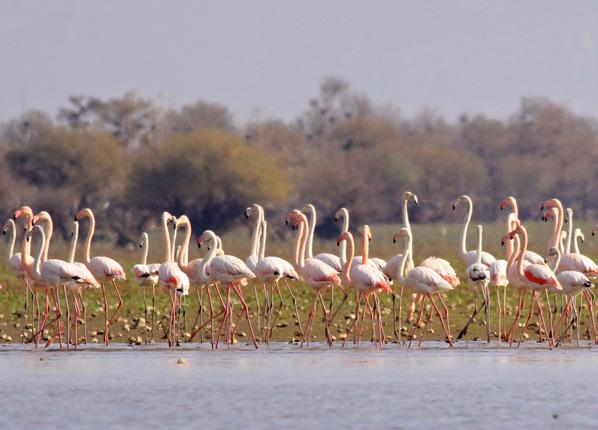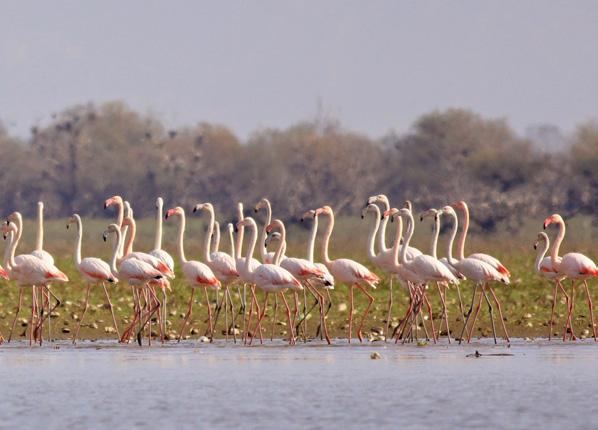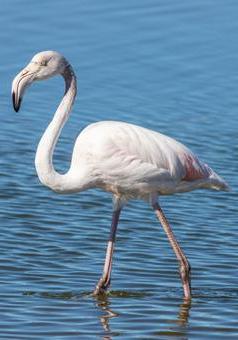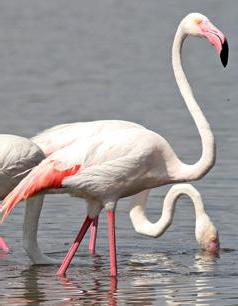
7 minute read
FLAMBOYANT FLAMINGO’S
PRETTY IN PINK
Or maybe not... Jake Cleaver shares what he learned about these intriguing birds. And after doing some digging, it seems they are more than just flamboyant Flamingos
Advertisement
Have you ever seen a flamboyance of Flamingos here in the Algarve and thought to yourself, “Aren’t they supposed to be pink?”. Maybe you even heard somebody say that it’s because they don’t eat enough prawns in their diet, you know, in a “you are what you eat” kind of way. Like how if we eat too many carrots we turn orange and glow in the dark. And like the carrot thing you felt that it sounded a little far-fetched. Well, I’m here to tell you that I looked into it, and it’s actually true. The Flamingo thing at least. I’m not sure about the carrot, however, I’m slightly more convinced now as I found out that the same beta carotene that makes Flamingos pink is found in high levels in carrots too.
So, Flamingos are what they eat. But it’s not quite as simple as that.. They do turn pink from eating shrimps, but only if the shrimps have eaten lots of red algae. If there is no red algae around, they can eat all the shrimps they want, and they will still be as white as snow. So actually: they are what they eat - eats. There are 6 species of Flamingos in the world. The ones that grace our shores are known, rather immodestly, as the Greater Flamingos. But we’ll let them off, as they are unarguably the largest of all the Flamingos. They can grow up to a considerable 150cm tall, but the most they weigh is a little over 4kg. So, despite their superior size, they can still take to the sky.
And they do. Flamingos aren’t native to the Algarve; they are just flashy tourists here from North Africa and the Middle East. In fact, the Algarve only started to become a popular holiday destination for them (and us humans too for that matter) as recently as the 1980’s. However, Portugal is one of the few places they don’t nest. They just come here for their honeymoon, and move along to Spain, Italy, France and sometimes all the way to Turkey to have their babies (maybe the maternity leave deals are better?).
But before all that, Flamingos have to find a partner, and they have a great dating ritual. First off, they secrete some sort of preening oil. Where from isn’t clear, nobody would tell me, maybe I don’t want to know? But it’s filled with the

same pigments that make them pink in the first place. They use it as a sort of makeup that they rub all over themselves in the breeding season to make them even pinker. You see, for the Flamingos it’s the lady with the most fabulous pink dress (and a slight blush on her cheeks) that gets her pick of the boys, and, unfortunately, it’s the guy with the loudest most obnoxious flamboyant shirt - that she usually picks. Typical.
Anyway, once they are all preen and proper and conditions are right (it’s a nice day and love is in the air) they hold a sort of village dance, or like they have here in Portugal, a Baile. The bravest males head to the dance floor, bobbing their heads up and down trying to get the party started. If they get it right (timing is important) then they all start to dance. I was delighted when I found this out, as I was dying to say that the Flamingos dance the Flamenco. And they sort of do.. There’s certainly a lot of fancy footwork involved.

But for the Flamingos it’s all or nothing. Nobody in the town is allowed to sit it out. Everybody’s crazy Grandma and grumpy Uncle have to join in too. They all huddle together and move as one. And, if some of the younger ones in the club find someone with some sweet dance moves, and doesn’t step on their toes during the slow dance - they mate for life.
And life can be quite a long time. They can live up to 50 years in the wild. Although on average they only make it to about 30. In captivity though there was apparently one in Australia who got up to an impressive 83.


Flamingos, despite their flamboyant reputation, aren’t so easy to come across. You have to go looking. They have very long legs and like a paddling pool and places where the water is a consistent depth. Consequently, your best shot will be to head down to the Ria Formosa. Try walking along the Ludo Trail between Quinta do Lago and Faro beach. Or, along either side of the Gilão River in Tavira there are many saltpans and mudflats and it is a serious hotspot for them. Or, in the other directions there’s a saltwater Lagoon on the north-western side of the Ria de Alvor which is a good bet too. Although they can be found all year round, the best times to look are between November and March.
They also have an unusual hunting technique. Now, I’m not a fisherman. But I would have thought you’d want to keep the water peaceful and clear so you can see what you’re doing. Flamingos use their webbed feet to stir up the water into a big muddy mess, and then - they stick their faces straight into it. This works for them as they have a highly sophisticated filtration system in their crooked beaks. It’s this odd shape of their beaks and how they hang their heads almost upside down (that’s also why their necks are all so curvy and shaped like S´s) that allows them to let in all the muddy water and then push it straight out again with their tongues. Kind of like straining spaghetti, they catch all the good stuff like shrimp, insects, larva, algae and small fish; while the water and mud pours out the sides. They do this all very fast and continually, and it is quite an odd way for a bird to eat, and is a lot more similar to that of whales.
Another feature of their high-tech beaks is they can also produce milk. Yeah, I know, wild right? You may have thought that you had to be a mammal (and have nipples) to be able to provide milk for your young. But no, some birds can too. Pigeons, Emperor Penguins and Flamingos all have this ability. When Flamingos are born their beaks are too small and flat - and they have no filter (like most kids they haven’t learned to censor themselves yet and will just blurt anything out). So both their mum, and it gets even weirder, their dads, produce milk that they shoot out through their beaks for their children. The milk is also filled with that beta carotene that makes the Flamingos pink. But it comes from their own reserves. Parents everywhere give up a lot of themselves in order to see their progeny grow up big and strong, but nowhere is it so startlingly apparent than with the Flamingos. As their children grow and become brighter and more radiant, the colour starts to drain out of the exhausted parents.
But don’t feel too bad for them. They usually only have one baby at a time, and they are extraordinarily attuned to what The Joneses are doing, and either everybody has babies, or nobody does. So soon the kids get off to Kindergarten and they all help each other out (with school runs and the like).
Also, you might think if you saw them standing around on one leg in their signature stance, that their knees are bent backwards. That’s not the case, as strange as it may seem, that’s their ankle. Which they can lock in place and then they balance on one leg, which is actually easier for them than standing on two, and ensures they have a leg free to help them get out if they get stuck in the mud. Their knee is actually in their torso and works a bit like our hips to move from side to side. * I originally thought it was just Flamingos that walk on their tippy toes like this, but no, dogs, cats, horses and lots of other birds have their ankles where we think their knees should be, too.
I’ve never used the word flamboyant so much in my life, but I think I’m allowed in this case, as the word seems to have been made especially for the Flamingo. They travel in huge Flamboyances, and are very social animals. Safety in numbers seems to be their motto.
And, since there are so many of them, maybe they won’t notice you if you put on your pinkest most flamboyant shirt and try to sneak up close to have a look at them? Careful though, you might just get inundated with invitations to dance the Fabulous Flamingo Flamenco.










